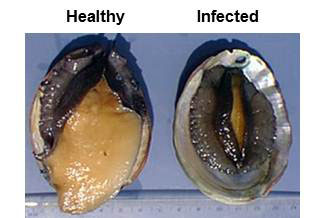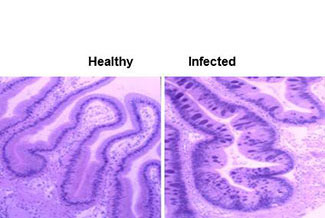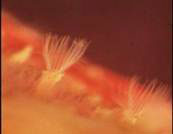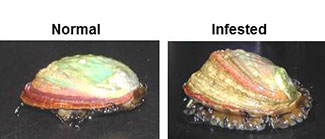Withering Syndrome
Withering Syndrome, caused by the intracellular bacterium candidatus Xenohaliotis californiensis, has severely impacted wild abalone populations since it was first discovered at the Channel Islands in 1985. The causative agent is now believed to be present in all abalone populations from Mexico to Sonoma County. The characteristic sign of the disease is a shrunken foot muscle. All seven California abalone species are susceptible to infection, but how they are affected varies between species and with water temperature. We anticipate that North Coast red abalone populations will not be as severely affected as those in southern California because the cold water temperatures slow or prevent expression of the disease.
 Farmed red abalone (Haliotis rufescens). The animal on the right shows classic signs of WS.
Farmed red abalone (Haliotis rufescens). The animal on the right shows classic signs of WS.
 Gut tissue of red abalone. The purple inclusions in the cells of the abalone on the right are colonies of WS bacteria.
Gut tissue of red abalone. The purple inclusions in the cells of the abalone on the right are colonies of WS bacteria.
Sabellid Pest
The sabellid polychaete worm Terebrasabella heterouncinata was accidentally introduced to California’s abalone farms from South Africa in the late 1980s. By 1995, almost every abalone farm and many aquaria in the state were harboring this non-native pest. The worms, which live in tubes within the abalone shell, cause severe shell deformities making them prone to breakage and resulting in slow growth. An eradication plan created by UC Santa Barbara, CDFW, and abalone farmers exterminated the pest at farms and prevented new infestations. We continue to monitor abalone farms, public and research aquaria, and wild gastropods to assure eradication of this pest.
 The filter-feeding apparatus of the worm.
The filter-feeding apparatus of the worm.
 Normal and infested farmed red abalone.
Normal and infested farmed red abalone.